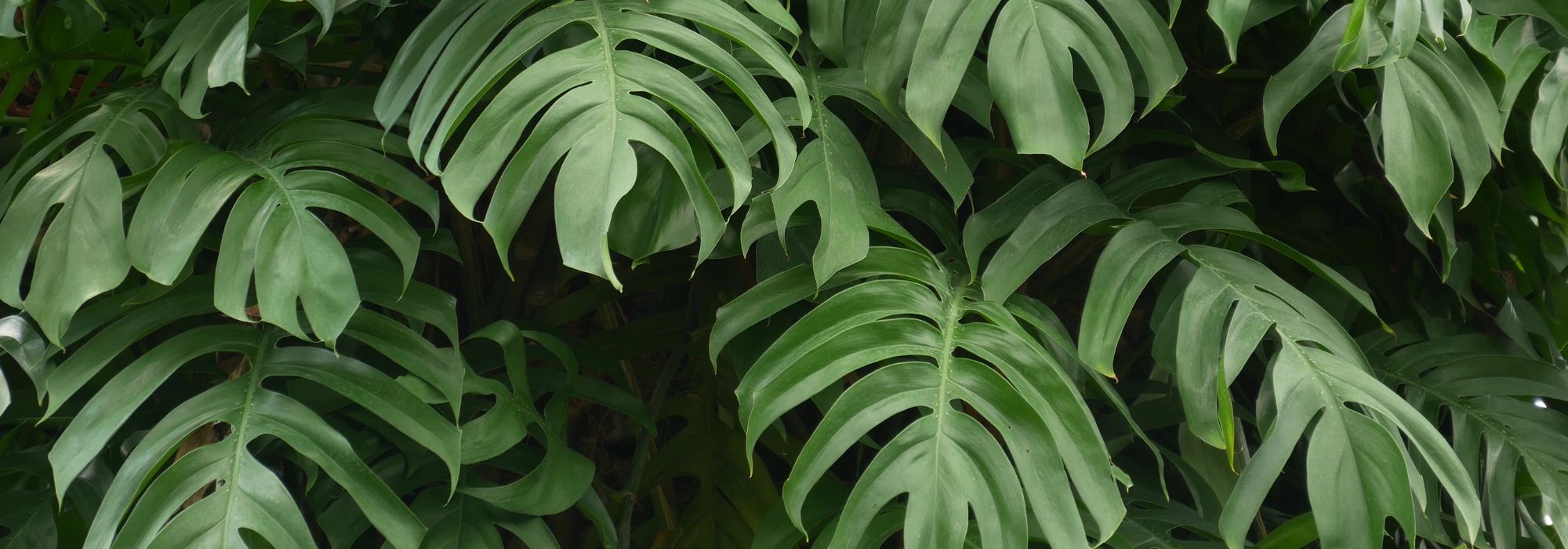
Monstera: growing and caring
Contents
Monsteras in a nutshell
- Monstera is a tropical climbing plant prized for its spectacular foliage.
- Easy to care for, it thrives in indirect light and in a well-draining substrate.
- A moss pole can help it grow vertically.
- The false philodendron fits into all interior styles, from bohemian to modern.
The word from our expert
Majestic and striking, the Monstera are tropical plants from the Araceae family, prized for their spectacular foliage. Native to the forests of Central and South America, these climbing plants cling to tree trunks using their aerial roots, thriving under the canopy in a humid and bright environment. Their name, derived from the Latin monstrum, is said to refer to the remarkable perforations and cuts in their leaves, a natural phenomenon known as fenestration. Among the most popular species are the Monstera deliciosa, with its large, split leaves, and the Monstera adansonii, with its finely perforated foliage.
Easy to care for, Monstera thrive indoors under indirect light and in well-draining soil. Watering should be moderate, allowing the surface of the soil to dry out between waterings to prevent root rot. To encourage growth, a moss pole can be installed to guide their climbing habit. Regular cleaning of the foliage helps optimise photosynthesis and maintains the leaves’ shine.
In décor, the Monstera stands out as a must-have for the urban jungle style, but it also fits perfectly into Scandinavian, modern, or industrial interiors. With its imposing leaves and natural elegance, this timeless plant continues to captivate botany enthusiasts and interior design lovers alike.
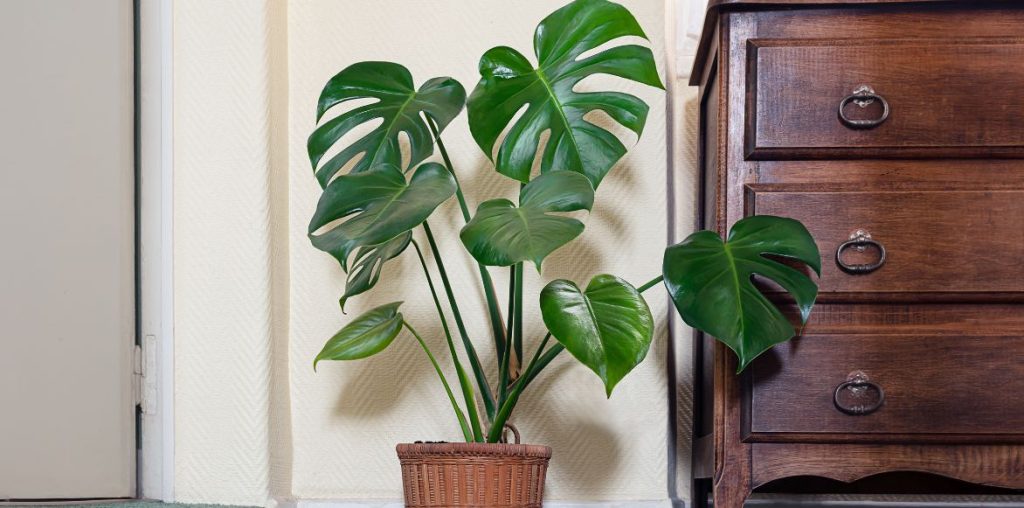
The Monstera is a classic houseplant, yet always appreciated.
Botany and description
Botanical data
- Latin name Monstera deliciosa
- Family Araceae
- Common name Monstera, Swiss Cheese Plant
- Flowering spring
- Height up to 3 m tall
- Exposure partial shade or bright, without direct sunlight
- Soil type rich, well-drained
- Hardiness frost-sensitive
Monstera are tropical plants belonging to the Araceae family, a large family that includes many popular houseplants prized for their ornamental foliage, such as philodendron, alocasia, spathiphyllum, or anthurium. The genus name Monstera comes from the Latin monstrum, and may refer to the dramatic perforations and cuts in their leaves, which give these plants an appearance as strange as it is impressive. In French, the most commonly cultivated species, Monstera deliciosa, is often called “Swiss Cheese Plant,” “Faux Philodendron,” or simply “Monstera.”
In their natural habitat, these plants climb along tree trunks in the tropical forests of Central and South America, taking advantage of the ambient humidity and the light filtered through the canopy. Their adaptation to these conditions allows them to thrive indoors, where they have become staples of plant decor. Their popularity stems from their spectacular foliage, vigorous growth, and relative ease of care, making them accessible to everyone.
Among the most commonly cultivated species and varieties are the classic Monstera deliciosa, iconic for its large, deeply cut leaves, and Monstera adansonii, prized for its more delicate perforated foliage. The Monstera obliqua, much rarer, is often confused with the adansonii but is distinguished by even more pronounced perforations and thinner foliage. The Monstera ‘Thai Constellation’, a variegated variety of deliciosa, is highly sought after for its white and cream marbling, resulting from a stabilised laboratory mutation. There are also lesser-known but equally interesting species, such as the Amydrium medium ‘Silver’, which boasts unique silver foliage and an elegant growth habit, adding an exotic and original touch to interiors.
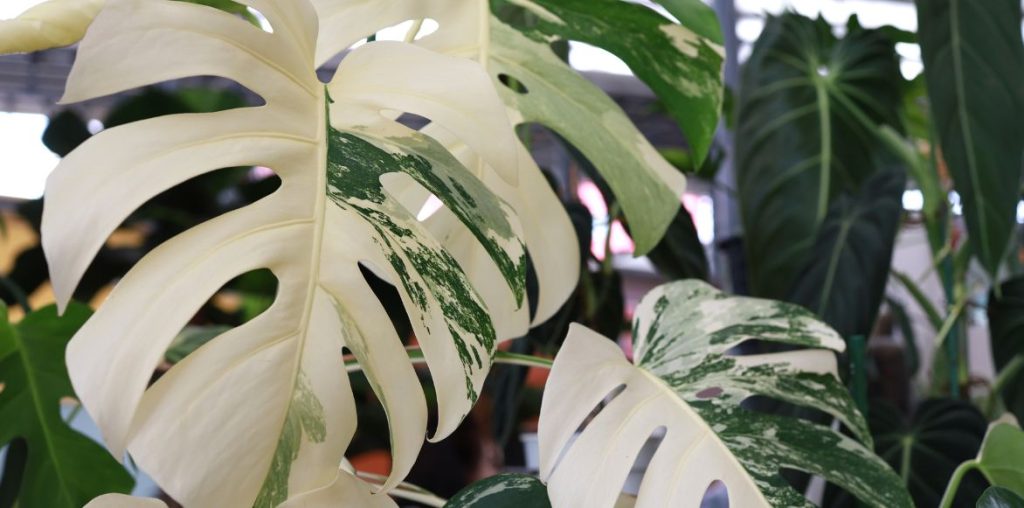
Variegated varieties like this Monstera deliciosa ‘Variegata’ are highly sought after.
Plant Morphology
Monstera are tropical plants with a climbing or trailing habit, depending on how they are cultivated. In their natural environment, they cling to tree trunks using their aerial roots, allowing them to exploit available light while remaining anchored in the soil. Indoors, they retain this habit and develop long roots that can be directed toward a support or left free, giving the plant a wild and lush appearance.
Their root system is both underground and aerial. While the underground roots provide anchorage and nutrient absorption, the aerial roots play a crucial role in capturing moisture and supporting the plant as it climbs. In Monstera deliciosa, these roots are particularly thick and tough, whereas in Monstera adansonii, they are finer and more numerous, easily intertwining around a stake.
Monstera do not have a lignified trunk per se. Their structure consists of a thick, fleshy stem that elongates over time, producing nodes from which leaves and roots emerge. This stem can branch, especially when the plant is pruned, but it generally tends to grow in one direction, coiling around itself or extending toward the light.
The foliage is undoubtedly the most iconic feature of Monstera. It evolves with the plant’s age, transitioning from entire leaves to split or perforated leaves. In Monstera deliciosa, young leaves are initially solid, then gradually develop deep cuts and perforations—a phenomenon called fenestration—which may help the plant withstand tropical winds and maximise light penetration through the canopy. The Monstera obliqua, on the other hand, produces leaves so perforated that they seem to consist more of holes than actual material.
Although flowering is rare indoors, Monstera produce a typical Araceae inflorescence in the wild: a spadix enveloped by a spathe. In Monstera deliciosa, this inflorescence can yield an edible fruit with a sweet flavour, reminiscent of a mix between banana and pineapple. However, the fruit takes several months to ripen and should only be consumed when fully mature, as the unripe parts contain irritating calcium oxalate crystals.
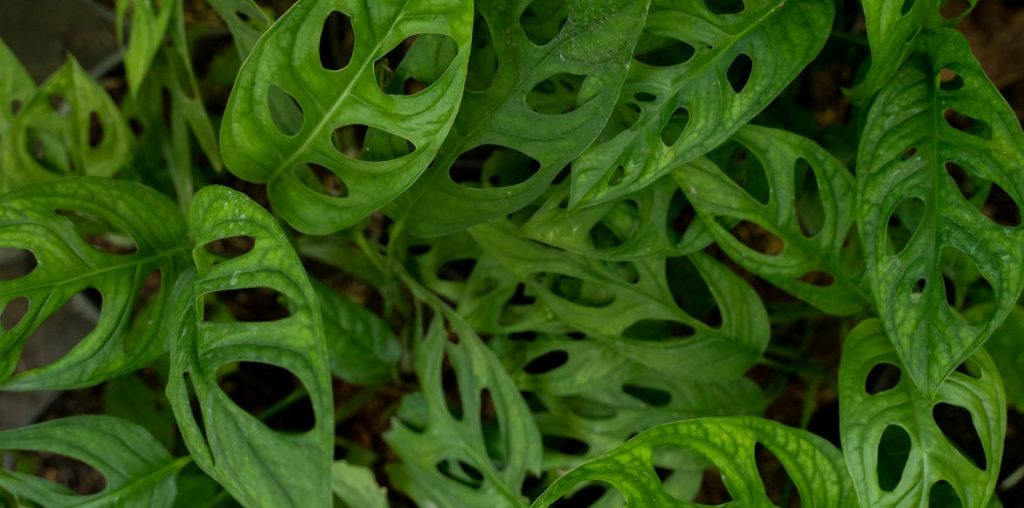
The Monstera adansonii is less well-known than Monstera deliciosa but requires the same care.
When and how to plant a Monstera in a pot?
The Best Time to Plant or Repot a Monstera
The ideal time to plant or repot a Monstera is in spring or early summer, when the plant enters its active growth phase. This allows it to quickly adapt to its new substrate and develop new roots before winter.
Choosing the Substrate: Light and Well-Draining Above All
A Monstera thrives in a substrate that retains moisture without becoming waterlogged. The ideal mix is well-aerated, rich in organic matter, and well-draining. A good blend can consist of universal potting soil mixed with perlite or pumice to lighten the texture, and a bit of pine bark to promote root aeration. Alternatively, a high-quality indoor plant potting mix will work perfectly.
Note: For a Monstera ‘Thai Constellation’, which is more prone to root rot, an even more draining substrate, similar to an orchid mix, is recommended.
The Ideal Location: Light, Temperature, and Humidity
Monstera prefers bright, indirect light near a well-lit window, but without direct sunlight, which could scorch its leaves. It can tolerate lower light, but this will slow its growth and reduce the appearance of fenestrations.
In terms of temperature, it thrives between 18 and 28°C and dislikes the cold. Below 10°C, its growth slows significantly, and below 5°C, it risks irreversible damage. It loves high ambient humidity (ideally above 60%), which can be achieved with a humidifier or by placing a tray of water and clay pebbles nearby.
Choosing the Pot: Material and Size Matter
Monstera needs a pot with drainage holes, otherwise its roots may rot. The material can vary based on preference: Terracotta pots are a good choice to avoid excess moisture due to their porosity, but the substrate dries out faster.
The pot’s diameter should be 2 to 5 cm wider than the root ball to prevent excess substrate from staying too wet. A pot that’s too large retains too much water, while one that’s too small may hinder growth.
How to Plant a Monstera in a Pot: Step by Step
- Prepare the pot: Place a drainage layer at the bottom (clay pebbles or gravel) to prevent water accumulation.
- Partially fill the pot: Add a layer of well-aerated substrate.
- Install the plant: Remove the Monstera from its original pot, loosening the roots slightly if they are too compact.
- Position correctly: Place the root ball in the centre of the pot, ensuring the collar (base of the stem) remains at the same level as in the old pot.
- Fill and lightly tamp: Add substrate around the roots without compacting too much to maintain good aeration.
- Water thoroughly: A first watering helps moisten the substrate and eliminate air pockets.
Repotting: When and How to Do It?
A Monstera should be repotted every 2 to 3 years, or when it becomes too cramped and its roots start emerging from the drainage holes. During repotting, you can trim damaged roots and replace the depleted substrate. For very large plants, top-dressing (replacing the top layer of substrate) may suffice.
Staking: Guiding Growth with a Support
As a climbing plant, Monstera can be staked to encourage a more upright habit and prevent it from drooping under its own weight. A moss or coco fibre pole is ideal, as it allows aerial roots to cling to it.
To install a support properly:
- Place it during repotting to avoid damaging the roots.
- Gradually tie the stems with soft ties or raffia, without tightening too much.
- Mist the support occasionally to encourage aerial roots to attach.
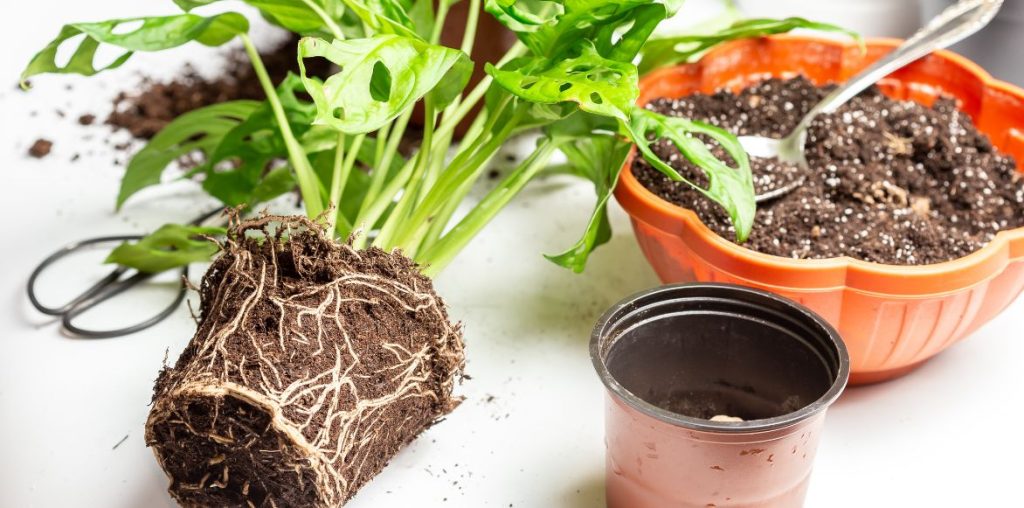
How to care for a Monstera?
Watering: Finding the Right Balance
The Monstera prefers slightly moist soil but dislikes excess water. Generally, you should water when the top few centimetres of soil are dry. The frequency varies depending on the season:
- Spring and summer: about once a week, or more if the air is dry or the plant is in active growth.
- Autumn and winter: space out watering (every 2 to 3 weeks) to prevent root rot.
Ideally, use non-calcareous water at room temperature. Excess water can lead to yellowing leaves, while a lack of water causes leaves to curl in on themselves.
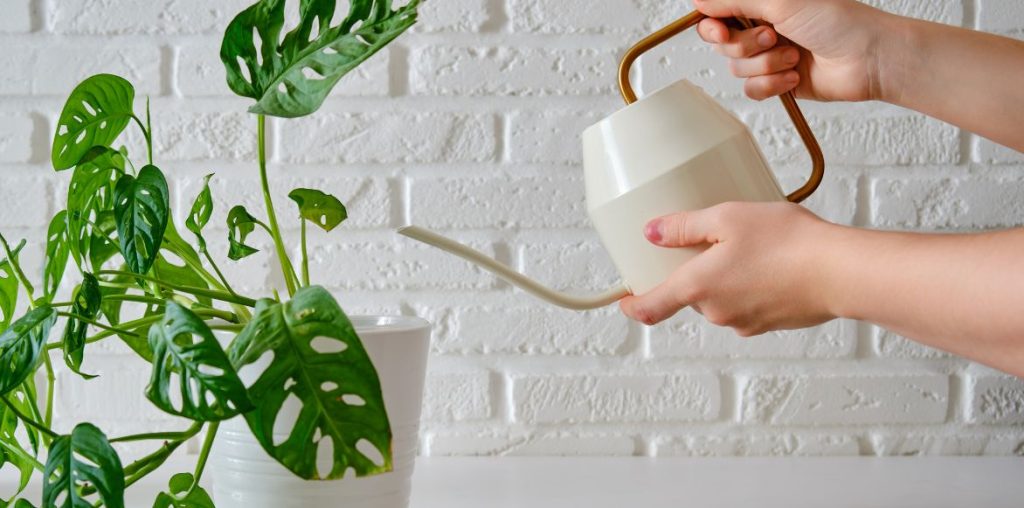
Fertilisation
The Monstera is a nutrient-hungry plant, especially during active growth. To help it develop beautiful leaves and grow well, it’s advisable to add a nitrogen-rich liquid fertiliser (e.g., NPK 8-4-4) every 2 to 3 weeks in spring and summer.
You can also opt for more natural solutions:
- Liquid compost or compost tea
- Adding coffee grounds (in moderation) for a slight nitrogen boost
In autumn and winter, it’s best to reduce or stop fertilisation, as the plant naturally slows its metabolism.
When and Why Prune a Monstera?
The Monstera doesn’t necessarily require pruning, but a few actions can be helpful:
- Remove yellowed or damaged leaves to keep the plant healthy.
- Prune overly long stems to limit expansion or encourage a more compact shape.
- Pinch young shoots to encourage branching and achieve a denser Monstera.
Pruning in early spring is ideal, before the plant enters active growth. The cuttings can be used for propagation by cuttings to multiply the plant.
Precautions: Avoiding Common Mistakes
- Aerial roots should not be cut entirely, as they help the plant feed and stabilise itself. They can be redirected towards the soil or moistened to prevent them from drying out.
- Watch out for drafts and low temperatures: a Monstera exposed to temperatures below 10°C may develop black spots on its leaves and experience a sudden slowdown in growth.
- Leaf maintenance: large leaves easily accumulate dust, reducing their ability to absorb light. Regular cleaning with a damp cloth keeps the plant in top condition.
Potential Pests and Diseases in the False Philodendron
The Most Common Parasites
-
Mealybugs : These small, white, cottony insects settle on stems and under leaves, feeding on the sap and weakening the plant. They are recognisable by their fluffy appearance and yellowing leaves. Solution: clean with a cloth soaked in 70° alcohol or apply diluted black soap.
-
Thrips: These tiny black or translucent insects cause discoloured and silvery spots on leaves. Highly invasive, they thrive in warm, dry conditions. Solution: spray a mixture of soapy water and vegetable oil.
-
Spider mites: These microscopic mites appear mainly in dry air. Fine webs and leaves turning yellow/brown are telltale signs. Solution: increase ambient humidity by misting the plant, rinse the leaves, and treat with black soap or neem oil.
-
Aphids: Although rare on Monstera, they can appear on young shoots. They weaken the plant and encourage the development of sooty mould (a blackish fungus). Solution: spray with soapy water.
Diseases and Physiological Problems
-
Root rot: This occurs due to overwatering or poorly drained substrate. The roots turn black and soft, and the plant wilts despite moist soil. Solution: cut off affected roots, repot in a dry and airy substrate, and space out watering.
-
Brown spots on leaves: Often caused by dry air or sunburn. If they are soft and spreading, it may indicate a fungal infection due to excessive humidity. Solution: adjust watering and avoid splashing water on the foliage.
-
Yellowing leaves: This can be due to overwatering, lack of light, or nutrient deficiency. Solution: adjust watering, move the plant to a better light source, and fertilise if necessary.
-
Curling leaves: A sign of water stress, either from lack of water or excess. Solution: check soil moisture and adjust watering.
How to propagate your Monstera?
Stem Cutting Propagation
This is the most common and quickest technique to propagate a Monstera, particularly Monstera deliciosa and Monstera adansonii.
- Choose a healthy stem: the cutting should include at least one node (the point where leaves and aerial roots attach), as this is where new roots will emerge.
- Make a clean cut: just below a node, using clean and sharp pruning shears.
- Place in water or substrate:
- In water: place the cutting in a container of water, ensuring the node is submerged but not the leaves. Change the water every 2-3 days.
- In soil: plant the cutting directly in a mix of compost, perlite, and pine bark, keeping the substrate slightly moist.
- Wait for roots to appear:
- In water, the first roots will appear within 2 to 6 weeks.
- In soil, the process is slower, but the plant adapts directly to its environment.
- Repot the cutting: once the roots are well-developed (at least 5 cm), transplant the cutting into a pot with suitable substrate.
Air Layering
Air layering is an excellent method if you want to ensure successful propagation before separating the cutting. It works very well for large stems of Monstera deliciosa.
- Choose a node with an aerial root.
- Wrap this node with damp sphagnum moss and cover it with plastic film to retain moisture.
- Wait for roots to develop (this can take several weeks).
- Once the roots are well-formed, cut below the node and repot the new plant.
Tips for Success
- Maintain good humidity: you can place the cutting under a cloche or in a mini greenhouse.
- Moderate light exposure: avoid direct sunlight but ensure good brightness to stimulate growth.
- Patience! Some cuttings take longer to root, especially in winter when growth slows down.
How to best showcase a Monstera?
The Best Indoor Spaces for Monstera
-
Bohemian and Urban Jungle Style: It thrives in a warm interior with natural materials like rattan, linen, and raw wood. Paired with other green plants, it transforms a living room or bedroom into a true tropical oasis.
-
Scandinavian and Minimalist Style: Its graphic foliage adds a soothing touch of greenery to clean interiors dominated by neutral tones and simple-lined furniture.
-
Industrial and Loft Ambiance: It creates an interesting contrast with metal, concrete, and exposed bricks. Its foliage brings softness and life to spaces with a raw and contemporary aesthetic.
-
Modern and Design Style: A large Monstera in a geometric or gold metal planter can become a focal point in a modern and sophisticated room.
Which Pot to Choose to Enhance a Monstera?
-
Raw Terracotta Pot: Ideal for a bohemian or Mediterranean style, it ensures good root aeration and prevents excess moisture.
-
White or Black Ceramic Pot: For a minimalist and elegant touch that highlights the contrast of the foliage.
-
Wicker or Rattan Planter: Perfect for a natural and cosy interior, it adds an artisanal and warm touch.
-
Metal or Wooden Raised Pot: Ideal for giving height and dimension to the plant, especially if it’s still young.
-
XXL Concrete or Stone Pot: For an industrial or contemporary ambiance, it adds character and presence to the Monstera.

A simple terracotta pot is more than enough to enhance such a plant.
Also worth reading...
You might also like…→ Discover our wide range of houseplants.
- Subscribe!
- Contents
































Comments